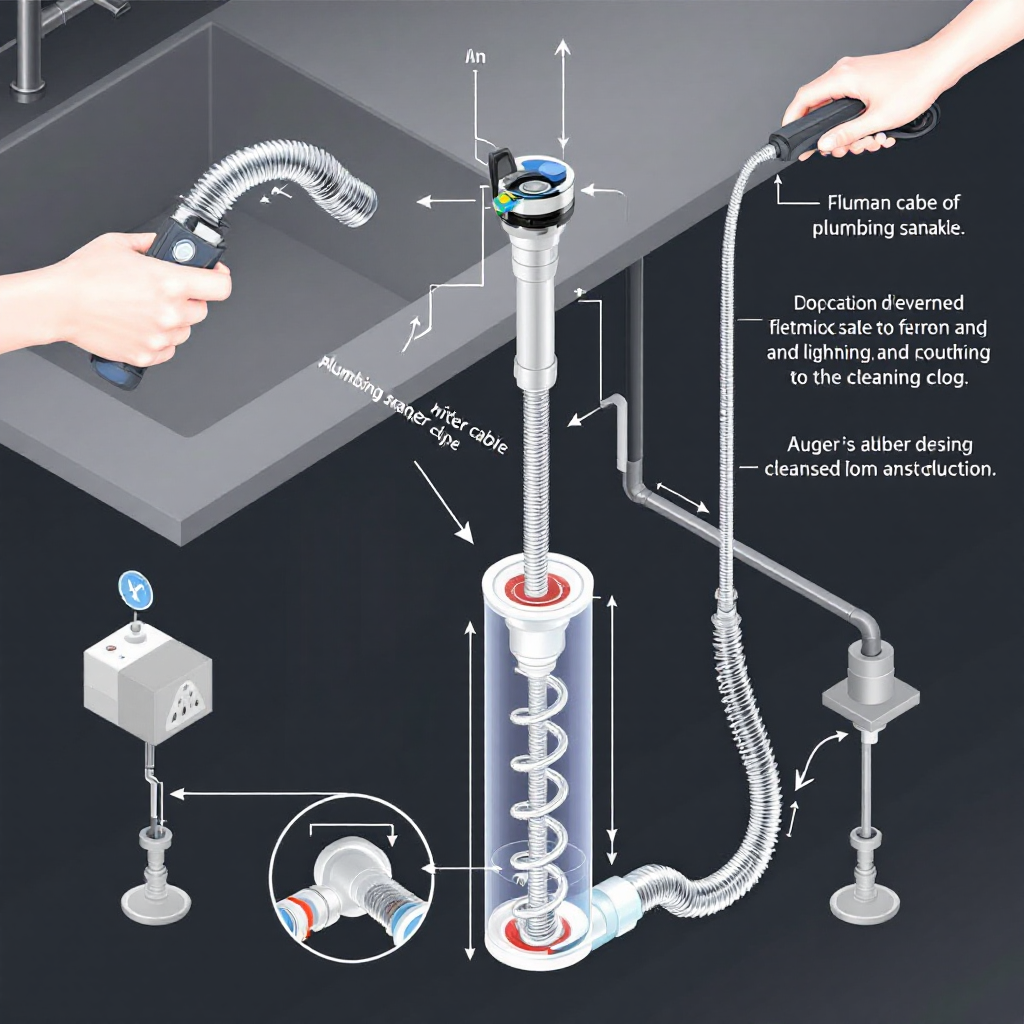If you’ve ever dealt with a clogged drain, you know the frustration it can bring. Slow-draining sinks, standing water in the bathtub, or a backed-up toilet can disrupt your day and lead to costly repairs if left untreated. But did you know that you can often fix these issues with the right tools and a bit of know-how? One of the most effective tools for this is a plumbing snake.
What Is a Plumbing Snake?
Definition and Purpose
A plumbing snake—a drain snake or drain auger—is a long, flexible metal cable with a coiled, cone-shaped auger at the end. It’s designed to navigate through pipes and break up or remove clogs. Snaking your plumbing is often the next step if a plunger doesn’t solve the problem.
The Snake works by physically dislodging or pulling out the blockage so water can flow freely through the pipes again. It’s an essential tool in many households for dealing with everything from hair-clogged bathroom drains to food-blocked kitchen sinks.
Key Components
A standard plumbing snake has three main parts:
- Flexible Cable – The long, flexible portion that goes into the pipe.
- Auger Tip – A cone-shaped or corkscrew-like piece that breaks up the clog.
- Handle or Crank – Used to feed the Snake through the pipe and rotate it for maximum effectiveness.
Plumbing Snake vs. Other Tools
It’s important to understand how a plumbing snake differs from other tools:
- Drain Auger: Similar to a snake but designed for larger pipes, such as outdoor drains.
- Power Auger: A motorized version of the Snake for heavy-duty clogs.
- Plunger: A basic tool for creating suction to dislodge minor clogs.
Remember these distinctions when choosing the right tool for your plumbing issue.
How Does a Plumbing Snake Work in a House?
A plumbing snake threads the flexible cable into your home’s plumbing system. The auger tip rotates as you turn the handle, cutting through or grabbing onto debris blocking the pipe. It’s particularly effective for common household clogs, such as hair, soap scum, grease, or food particles.
The Snake’s flexibility allows it to bend and navigate through tight pipe turns, including tricky spots like the P-trap under a sink. By physically breaking apart the clog, it restores proper water flow.
Types of Plumbing Snakes for Home Use
There are several types of plumbing snakes, each suited for different tasks. Here’s how to choose the right one for your needs:
Manual vs. Powered Snakes
- Manual Hand-Crank Snakes
- Best for light clogs in sinks, bathtubs, and showers.
- Requires physical effort to rotate and feed the Snake through the pipe.
- Powered (Electric) Snakes
- Ideal for tougher or deeper clogs.
- Equipped with a motor to rotate the auger tip, making it easier to clear blockages.
Specialized Snakes
- Toilet Augers: Specifically designed for toilets to avoid scratching or damaging porcelain.
- Mini Snakes: Perfect for small drains, like bathroom sinks or dishwasher lines.
Choosing the Right Snake
When selecting a plumbing snake, consider the following:
- Pipe Size: Use a larger snake for wider pipes and a smaller one for narrow pipes.
- Clog Location: Determine whether the clog is near the drain opening or deeper in the pipeline.
- Type of Blockage: Hair, grease, and solid debris require different levels of force to break apart.
Here’s a simple table to help you decide:
Type of SnakeBest for examples
Manual Snake Sinks, bathtubs, small clogs Hair, soap scum
Powered Snake Deep or stubborn clogs Grease, food debris
Toilet Auger Toilets Paper blockages, foreign objects
Mini Snake Narrow drains Bathroom sinks, appliances
When Should You Use a Plumbing Snake in Your House?
Common Household Clogs
Some blockages are more likely to occur in specific areas of your home. Common clogs include:
- Hair: Major culprit in bathroom drains.
- Soap Scum and Grease: Often found in kitchen and bathroom pipes.
- Food Debris: A frequent problem in kitchen sinks.
- Foreign Objects: Items like toys or jewellery accidentally dropped into drains.
Signs that you might need a plumbing snake include:
- Slow Draining Water: Indicates a partial blockage.
- Standing Water: Suggests a fully blocked pipe.
- Recurring Clogs: A sign that the original blockage wasn’t fully removed.
When Not to Use a Snake
There are times when snaking might not be the best solution:
- Old or Fragile Pipes: Snaking can damage already weak pipes.
- Major Sewer Line Issues: These require professional equipment and expertise.
- Persistent Clogs: If snaking doesn’t work, the problem might require a plumber.
Step-by-Step Guide: How to Snake Plumbing in a House
Ready to tackle your plumbing problem? Follow these steps:
Preparation
- Gather materials: plumbing snake, gloves, towels, bucket, flashlight.
- Wear safety gear, like gloves and eye protection, to avoid contact with dirty water.
Access the Drain
- Remove drain covers or stoppers.
- For sinks, detach the P-trap if the clog is deeper in the pipe.
Insert the Snake
- Slowly feed the Snake into the drain while turning the handle.
- Be gentle when navigating bends to avoid damaging the pipe.
Break Up the Clog
- When you feel resistance, you’ve likely reached the blockage.
- Rotate the handle to break apart the clog or latch onto it.
Remove the Snake and Clog
- Carefully pull the Snake out, bringing the blockage with it.
- Repeat the process if necessary until the drain is clear.
Test and Clean Up
- Run water to ensure the clog is gone.
- Clean the Snake thoroughly before storing it.
Troubleshooting: What If the Snake Doesn’t Work?
Sometimes, snaking doesn’t solve the issue. Here are common problems and solutions:
- Snake Won’t Go Through the Pipe: Try a smaller or more flexible snake.
- Snake Gets Stuck: Gently pull back without forcing it. If it doesn’t budge, call a professional.
- Persistent Clogs: If snaking fails repeatedly, there could be a deeper issue, like a damaged pipe.
Maintenance Tips to Prevent Future Clogs
Regular Cleaning Routines
- Use strainers to catch debris.
- Avoid pouring grease or large food particles down the drain.
- Perform monthly maintenance with natural cleaners or hot water flushes.
Care for Your Plumbing Snake
- Clean it thoroughly after each use to prevent rust.
- Store it in a dry place to extend its lifespan.
Safety Tips and Best Practices
Protecting Your Plumbing
- Avoid excessive force to prevent pipe damage.
- Know the layout of your plumbing system to avoid mistakes.
Personal Safety
- Always wear gloves and eye protection.
- Be cautious when using powered snakes to avoid injury.
Conclusion
Knowing how a plumbing snake works in a house can save you time, money, and frustration. By understanding the types of snakes, when to use them, and how to operate them safely, you’ll be well-equipped to handle most household clogs. However, don’t hesitate to call a professional if the problem persists or seems beyond your skill level. Have you ever used a plumbing snake? Share your experiences, or reach out for expert advice!
You may also read (guide to installing electrical wire next to home plumbing).
